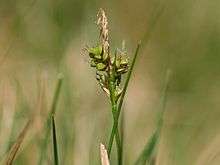Carex pilulifera
| Carex pilulifera | |
|---|---|
 | |
| Scientific classification | |
| Kingdom: | Plantae |
| (unranked): | Angiosperms |
| (unranked): | Monocots |
| Order: | Poales |
| Family: | Cyperaceae |
| Genus: | Carex |
| Subgenus: | C. subg. Carex |
| Section: | C. sect. Acrocystis |
| Species: | C. pilulifera |
| Binomial name | |
| Carex pilulifera L. | |
| Synonyms [1] | |
|
Carex oederi Retz. | |
Carex pilulifera, the pill sedge,[2] is a European species of sedge found in acid heaths, woods and grassland from Macaronesia to Scandinavia. It grows up to 30 cm (12 in) tall, with 2–4 female spikes and 1 male spike in an inflorescence. These stalks bend as the seeds ripen, and the seeds are collected and dispersed by ants of the species Myrmica ruginodis.
Description
The culms of Carex pilulifera grow to a length of 8–30 centimetres (3–12 in), and are often noticeably curved.[3] The leaves are 5–20 cm (2–8 in) long and 1.5–2.0 millimetres (0.06–0.08 in) wide, and are fairly flat.[3] The rhizomes of C. pilulifera are very short, giving the plant a caespitose (densely tufted) appearance.[3] The tussock grows outwards through the production of annual side-shoots.[4]
The inflorescence comprises a single, terminal, male (staminate) spike, and 2–4 lateral female (pistillate) spikes.[3] The spikes are clustered together, and the whole inflorescence is 1–4 cm (0.4–1.6 in) long.[3] The female spikes are 4–8 mm (0.16–0.31 in) long, ovoid or approaching spherical,[3] and contains 5–15 flowers.[4] The female spikes are attached directly to the stem, and each is subtended by a bract which does not form a sheath.[3] The male spike is 8–15 mm (0.3–0.6 in) long and much narrower.[3]
Distribution and ecology
Carex pilulifera has a wide distribution in Europe, extending from Macaronesia and the Balkan Peninsula to Scandinavia.[1] It grows on acidic substrates including heathland, grassland and woodland.[4] It typically inhabits soils with a pH of 4.5–6.0.[3]
As the seeds of C. pilulifera ripen, the culms bend, and can eventually touch the ground.[4] The seeds are then dispersed by ants, particularly Myrmica ruginodis,[4] in a process known as myrmecochory, and are eaten by other insects, such as the ground beetle Harpalus fuliginosus.[4]
Taxonomic history
Carex pilulifera was described by Carl Linnaeus in his 1753 work Species Plantarum, which marks the starting point of botanical nomenclature.[1] The specific epithet pilulifera means "bearing small globular structures", in reference to the female spikes.[5]
References
- 1 2 3 A. O. Chater (2010). "Carex". In T. G. Tutin; V. H. Heywood; N. A. Burges; D. A. Webb; I. B. K. Richardson. Alismataceae to Orchidaceae. Flora Europaea. 5. Cambridge University Press. pp. 290–323. ISBN 978-0-521-15370-6.
- ↑ "BSBI List 2007". Botanical Society of Britain and Ireland. Archived from the original (xls) on 2015-02-25. Retrieved 2014-10-17.
- 1 2 3 4 5 6 7 8 9 A. C. Jermy; D. A. Simpson; M. J. Y. Foley; M. S. Porter (2007). "Carex pilulifera L.". Sedges of the British Isles. BSBI Handbook No. 1 (3rd ed.). Botanical Society of the British Isles. pp. 431–433. ISBN 978-0-901158-35-2.
- 1 2 3 4 5 6 Gösta Kjellsson (1985). "Seed fate in a population of Carex pilulifera L. I. Seed dispersal and ant-seed mutualism". Oecologia. 67 (3): 416–423. doi:10.1007/BF00384949. JSTOR 4217752.
- ↑ "Pillerstarr, Carex pilulifera L.". Den virtuella floran (in Swedish). Naturhistoriska riksmuseet. July 28, 2010. Retrieved July 25, 2011.
External links
 Media related to Carex pilulifera at Wikimedia Commons
Media related to Carex pilulifera at Wikimedia Commons
